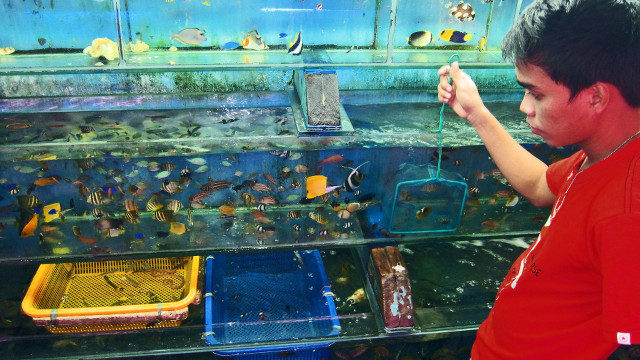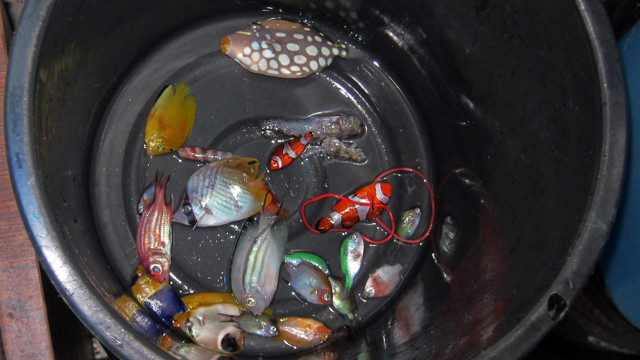SUMMARY
This is AI generated summarization, which may have errors. For context, always refer to the full article.

Wordlessly, the guardian of this humid, bubbling world scoops up the fish with a worn green net and chucks it into a plastic bag. “That’ll be 50 pesos.”
Welcome to Marine Fish Central, the Cartimar pet complex in Metro Manila’s Pasay City, where thousands of fish–and pesos–change hands daily. I’ve been in the boy’s shoes more times than I can remember, ever since our Lola took us to see “real live seahorses” in the 1980s.
Composed of about a hundred shops offering arowanas, tarantulas and everything in between, the complex has seen many changes but remains the country’s top aquarium fish hub.
Sea creatures for sale
There are 3 basic types of fish–saltwater fish from the sea, freshwater fish from rivers or lakes, and brackish water fish from zones where fresh and saltwater mix. Because of the volatile nature of rivers, most fresh and brackish water fish have learned to adapt to dramatic fluctuations in water quality.
Freshwater fish like the country’s introduced tilapia species can for example, rapidly adapt to brown-water conditions each time monsoon rains engorge rivers with mud and silt. In contrast, brightly-hued saltwater or marine fish live in the single most stable environment on Earth–the ocean–where large-scale changes occur not in days, but in millennia.
Because of this, most are unprepared for life in the average home aquarium, where water parameters fluctuate daily.

In the 1970s, new technologies such as canister filters, ultraviolet sterilizers, protein skimmers plus artificial sea salt finally allowed hobbyists to keep the sea’s living jewels.
By 1992, the annual trade in marine ornamentals soared to US$360 million (P15 billion), involving 36 million fish. Today the trade is valued at over US$1 billion (P43 billion), with 40 nations supplying some 2000 marine fish and 650 invertebrate species to a host of countries–primarily the United States (which imports half the world’s marine ornamental fish), Japan and Western Europe.
The Coral Triangle is Earth’s epicenter for marine biodiversity. Spanning the waters of the Philippines, Indonesia, Malaysia, Papua New Guinea, the Solomon Islands and Timor Leste, this extraordinary expanse of ocean covers approximately 6 million square kilometers, hosting 76% of the world’s coral species, 6 of the world’s 7 marine turtle species, plus over 3,000 species of fish.
Today, the Philippines and Indonesia remain the world’s top exporters of wild-caught marine fish, supplying about 85% of global demand. In 1998, the Philippines netted an estimated US$6.4M (P275 million) in marine fish exports–buoying the lives and livelihoods of around 4,000 aquarium fish collectors based throughout the archipelago.
However, 40 years of lightly-regulated collection compounded by cyanide use has decimated many reefs.
In many fish collection sites, high-value ornamentals like emperor angelfish and clown triggerfish are conspicuously absent. Since “Finding Nemo” premiered, soaring demand caused clownfish populations to plunge by as much as 75% in some areas.
Tips for a sustainable trade
As the planet’s leading environmental solutions-provider, WWF through its “Better Choices” program, recognizes that the trade in marine fish and invertebrates is a significant economic driver. However, it must be vigilantly managed to spare reefs additional damage and to minimize post-harvest mortality rates.

“Almost all wild-caught marine fish are taken from coral reefs. A 2004 study by the University of the Philippines Marine Science Institute (UP MSI) found that only 1% of the country’s coral reefs were in excellent condition,” reveals WWF-Philippines Vice-chair and CEO Jose Ma Lorenzo Tan.
“The world’s marine habitats continue to be assailed by climate change, pollution and unsustainable fishing. Obviously, poor fish and invertebrate harvest practices do little for conservation.”
A recurring issue is the use of sodium cyanide, thought to have originated in the Philippines in the 1950s. An efficient nerve-toxin, cyanide is squirted into coral heads or rock crevices to stun hard-to-catch fish. Unfortunately, the mixture burns both corals and the vital organs of fish–resulting in the deaths of up to 75% of all living things exposed to it.
“Regulated collection using nets and not poisons, better stocking and shipping techniques plus imposing sensible size, catch and species limits can provide collectors both sustainable livelihoods and a strong incentive to protect instead of exploit our reefs,” adds Tan.
In the South Pacific nations of Fiji, Tonga and the Solomon Islands, local communities are learning to sustainably farm hard and soft corals, giant clams and live rock (compacted corals or reef rock encrusted with marine life) for export to western markets.
WWF-Philippines now works on practical solutions for a sustainable marine aquarium trade. Its initial recommendations are the following:
1. Avoid hard-to-keep fish, especially cleaner wrasses, mandarin dragonets, Moorish idols and all types of seahorses. Mortality rates for these fish are estimated at 99% so it is best to ban them entirely.
2. Promote hardy fish. Many of the world’s most successful aquaria feature hardy but still colorful clownfish, damsels, gobies, wrasses and surgeonfish. Survival rates are far better and hobbyists end up spending much less for upkeep and stock replacement.
3. Shift to artificial corals and invertebrates. Unless you are a reef aquarium expert with cutting-edge equipment and a bottomless bank account, steer clear of all stationary invertebrates like corals, sponges and sea anemones. Their care is dramatically more complex than already difficult-to-keep reef fish and mortality rates are alarming. Moreover, harvesting wild hard corals for both the pet and curio trades is illegal. If tank-raised corals are unavailable, then artificial corals and reef blocks are excellent alternatives. The best part? You’ll only ever buy them once.
4. Shift to aquacultured fish and invertebrates. In stark contrast to freshwater aquarium fish, 95% of all marine fish and invertebrates remain wild-caught. Fortunately, the Bureau of Fisheries and Aquatic Resources (BFAR) recently approved a program where fish farmers can apply for wildlife ranching permits, allowing aquaculturists to collect a preset number of wild individuals as brood-stock in exchange for the release of 30% of juveniles back into the wild. Farmed seahorses and clownfish are popular in other countries–they might soon be available for Filipino hobbyists.
5. Raise the prices of saltwater fish and invertebrates. The reality of marine fishkeeping is that it is not for everyone. Higher prices limit the hobby to those with the time, resources and discipline to keep the animals alive. More importantly, this translates to better incomes for local fishermen, who will earn more from catching less fish.
Finally, hobbyists, pet stores and traders must self-regulate to ensure that new inductees are accorded the proper knowledge, training and respect for life needed to keep marine fish mortalities at an absolute minimum.
The marine aquarium trade certainly has its merits. Corals, giant clams and a growing list of fishes can now be cultured not just for profit–but to someday repopulate Earth’s denuded reefs. More importantly, the hobby cultivates a love and understanding of nature and its myriad processes.
Back at the fish store, a fresh batch of kids enters. Stopping to inspect the rows of aquaria, they fall silent.
As they watch and wonder at the swirling melee of color, I look back at another boy, gaping wide-eyed at a tank-full of “real live seahorses” almost 30 years ago. It all happened in Cartimar–where marines live, but never grow old. – Rappler.com
Recently chosen by Reader’s Digest Asia as a Philippine opinion leader, Gregg Yan serves as the Communications Manager of the World Wide Fund for Nature (WWF-Philippines). He’s a newly-minted master scuba diver who aims to make the world better through words and pictures. Add him on Facebook if you want to talk.
iSpeak is a parking space of ideas worth sharing. Send in your contributions to move.ph@rappler.com.
Add a comment
How does this make you feel?






There are no comments yet. Add your comment to start the conversation.